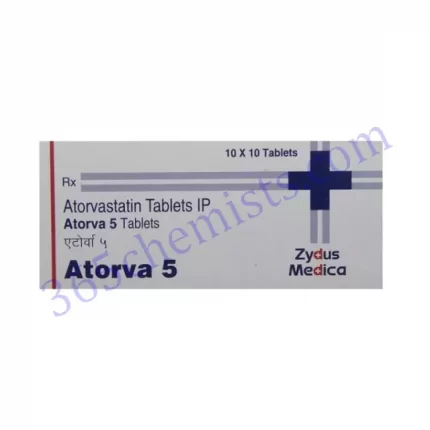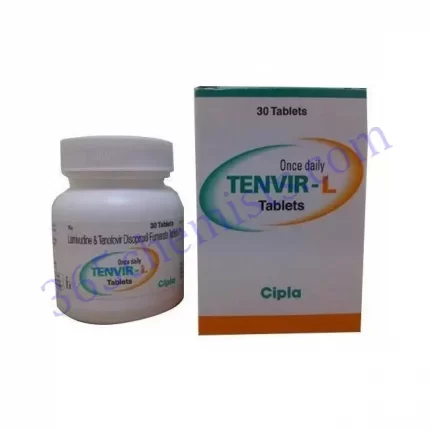Tavin EM Tablet (Emtricitabine 200mg/Tenofovir disoproxil fumarate 300mg):
One of the most commonly prescribed medications for the treatment of human immunodeficiency virus (HIV) infection is called Tavin EM Tablet. This tablet contains a combination of emtricitabine (200 mg) and tenofovir disoproxil fumarate (300 mg), and it works by reducing the amount of virus in the body. It is an antiretroviral drug, which means that it is designed to inhibit the replication of the virus, which in turn lessens the toll that the virus takes on the immune system. The purpose of this article is to provide a comprehensive overview of Tavin EM Tablet, including information on its applications, mode of action, dosage, potential adverse effects, and safety considerations.
Uses
The primary application for the Tavin EM Tablet is the management of HIV-1 infection in adults and adolescents older than 12 years of age. It is an indispensable part of antiretroviral therapy (ART) regimens, functioning in tandem with other antiretroviral drugs to achieve viral suppression and improve immune function. Tavin EM Tablet works to prevent the replication of the virus by inhibiting the enzyme responsible for reverse transcriptase. This results in a lower viral load and a slower progression of the disease. It is an extremely important component in both the treatment of HIV infection and the prevention of acquired immunodeficiency syndrome (AIDS).
Mechanism of Action
Emtricitabine and tenofovir disoproxil fumarate, which are the active ingredients in Tavin EM Tablet, collaborate to inhibit viral replication in HIV-infected cells in a manner that is known as synergistic action. Emtricitabine is a nucleoside reverse transcriptase inhibitor (NRTI), which means that it stops the conversion of viral RNA into DNA. It does this by inserting itself into the chain of viral DNA that is growing and thereby preventing the chain from continuing to grow. On the other hand, tenofovir disoproxil fumarate is a nucleotide reverse transcriptase inhibitor (NtRTI), which means that it competes with natural nucleotides and causes chain termination during viral DNA synthesis. Together, these medications inhibit the activity of the reverse transcriptase enzyme, which stops the cycle of viral replication and lowers the amount of infectious virus in the body.
Dosage and Administration
A healthcare professional should determine the appropriate dosage of Tavin EM Tablet for the individual patient, taking into account factors such as the patient’s age, weight, renal function, and individual response. Tablets of Tavin EM can be taken orally and are intended to be consumed once daily, regardless of whether they are taken with or without food. The pill ought to be taken in its entirety, without being chewed or crushed in any way. It is of the utmost importance to strictly adhere to the recommended treatment regimen as well as the dosage that has been prescribed. If you skip doses or stop taking the medication without first consulting your doctor, this could lead to a return of the virus as well as the development of resistance to the drug.
Side Effects
Tavin EM Tablet, like any other medication, has the potential to cause certain side effects; however, not everyone will experience them. Headaches, nausea, diarrhoea, and fatigue are some of the common side effects that may occur. Mild abnormalities in liver function tests may also occur. These adverse effects are typically mild and fleeting, meaning that they go away on their own over the course of time and do not require any special treatment or attention. However, it is imperative that a medical professional be contacted in the event that any of these potential adverse effects continue or become more severe. There is a possibility that the Tavin EM Tablet could cause more serious adverse effects on a very infrequent basis. These adverse effects could include kidney issues, lactic acidosis, or liver toxicity. During treatment, it is recommended to perform routine monitoring of renal function as well as liver enzymes.
Precautions
It is imperative that any pre-existing medical conditions, allergies, or medications that are currently being taken be disclosed to the healthcare professional who will be prescribing the Tavin EM Tablet prior to beginning treatment with the medication. Emtricitabine and tenofovir disoproxil fumarate may interact with other medications, which may result in unwanted side effects or a diminished ability to treat the underlying condition. Patients who have a history of kidney or liver disease must have their condition carefully monitored while they are taking the Tavin EM Tablet. It is essential to abstain from drinking alcohol and avoid engaging in other high-risk behaviours that could potentially transmit HIV to other people. It is recommended that people who are taking Tavin EM Tablet have their renal function, bone density, and HIV viral load monitored on a regular basis.
Conclusion
The antiretroviral therapy that is used to treat HIV infection includes the medication known as Tavin EM Tablet. This tablet contains a combination of emtricitabine (200 mg) and tenofovir disoproxil fumarate (300 mg), and it is one of the essential components of this treatment. It does this by inhibiting the replication of the virus, which helps reduce the viral load, improve immune function, and slow the progression of the disease. When trying to achieve the best possible results, it is absolutely necessary to take the medication exactly as directed and to stick to the treatment plan that was suggested. When incorporated into an all-encompassing HIV management strategy, Tavin EM Tablet has the potential to significantly enhance the quality of life of people living with HIV while also contributing to the fight against the global spread of the virus. The utilisation of Tavin EM Tablet in a manner that is both safe and effective requires consistent monitoring as well as open lines of communication with medical professionals.












